I’m in the midst of a spate of Gragg postings, mostly because that’s what I’m doing a lot of and I don’t think posting a steady diet about working my way through a book manuscript is all that interesting.
In building a Gragg chair there are two steps that are immensely time consuming. The first is fitting the rear seat rail into the side units, which serves to unify and distribute all the weight stresses. This takes about 4-8 hours for me to do this one element, it depends on how much magic is in my hands and how well my good eye is working that day. The other is cutting 17 open dovetail pocket joints, two on each of the six short splats and the front rail fittings for the five continuous splats. No way to put lipstick on that pig, they are nothing short of tedious. It generally takes me up to two days to finish them.
Cutting the insides of a dovetailed open mortise is just a pain, or at least it’s a pain by the eighth or ninth one. I’ve used a variety of tools and approaches — a saw, bench chisels, a skew chisel, utility knife, and especially a fish-tail flat gouge. The last was especially helpful but store-bought versions were just not quite right. The splay of the tool tip was too modest to really get into the sharp inside corners. I made a custom one for this purpose a couple chairs ago but for the life of me cannot find it now. Instead I decided to make another.
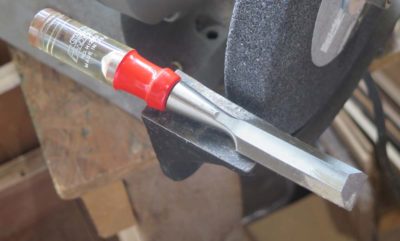
Looking through my box of derelict or disposable tools I found a 3/4″ Stanley “Handyman” chisel. It was a cheap almost cheezy tool of unknown provenance that still had the factory bevel and back. I recall modifying two of its siblings into 1) a dovetail chisel for small corner dovetails and 2) a small, short 3/16″ mortising chisel (this was before I fashioned my set of mini-mortise chisels out of plow plane irons). The thickness of the 3/4″ chisel steel is laughably thin for typical woodworking, but the thickness was precisely what I was looking for.
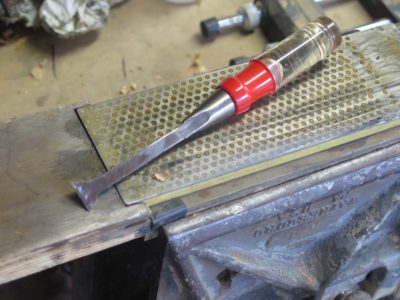
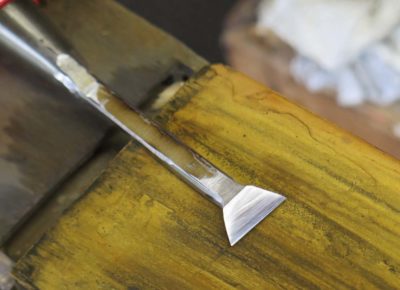
With my stationary grinder I created an extreme splay on the fishtail end of the chisel. Being careful and cutting in from the side I managed to avoid de-tempering the bevel. After running it through my usual sharpening routine I gave it a try.


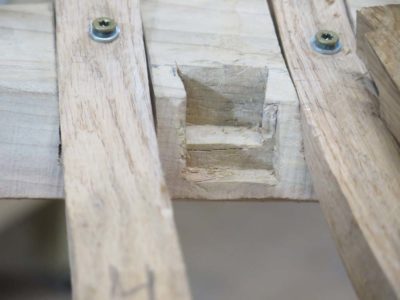
Absolutely splendid!
It is now an indispensable part of my Gragg tool kit, executing the task perfectly. Even better it reduces the time for cutting one of the dovetailed pockets from an hour to 45 minutes or less. Admittedly, since all of Gragg’s chairs are painted thus obscuring the exact nature of this joint I had to reverse-engineer something that I thought seemed right.
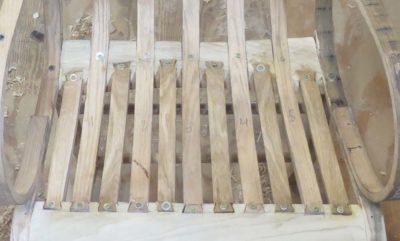
When you have to do 17 of them for each chair, ease and speed count for a lot.
Making this chisel was an extremely well-spent 90 minutes.

So there I was working away during my Gragg Chair Challenge, deep in the midst of the most tedious part of the entire project — fitting the seat slats into their dovetailed open mortises. At that same moment I was completely engrossed in listening to an Econtalk podcast wherein host Russ Roberts was interviewing statistician Nassim Nicholas Taleb on the latter’s observations about Covid-19 (Taleb’s observations cause me to stop and pay attention; I cannot tell sometimes whether he is a man of rare insight or a BS-spewing grifter. As Mark Twain said, “There are lies, damned lies, and statistics.” Taleb himself vacillates between statistics-as-analysis and mathematical-esoterica-as-intimidation).
It must have been a particularly compelling exchange between Roberts and Taleb because I sawed the slat cleanly on the wrong layout line. Try as I might, I cannot seem to stretch the piece longer to fit the space it is supposed to go.
It’ll go into the growing pile of kindling that is left after every Gragg chair.

When it comes to sharpening plane irons I am a sidewinder. I taught myself how to sharpen and this was the way that made the most sense to me as it exploits the natural kinesiology (the study of human motion) of the hand and arm. Straight-ahead sharpening fights the natural motions of the body as you have to constantly adjust the angles of the shoulder, elbow, wrist, and hand. Sidewinding takes advantage of the swinging motion of the arm. All you have to do is establish the bevel angle of the iron and everything else takes care of itself with minimal attention.
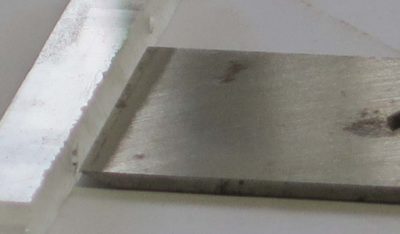
The pendulum motion of the swinging arm makes it almost effortless to shape a camber on a plane iron. This one was a new one for a Bailey #5.

My initial shaping of the bevel contour is done with a 60-grit belt on my 50-cent granite backsplash block. My first step is to gauge the bevel angle, which I determine by setting the iron bevel-down on the abrasive surface until the tip and the heel of the bevel are both in contact with it.
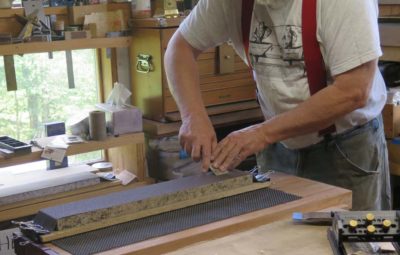
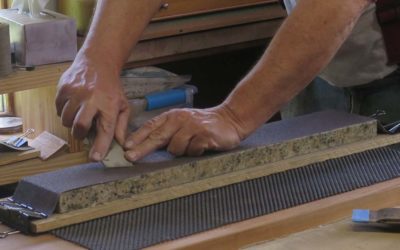
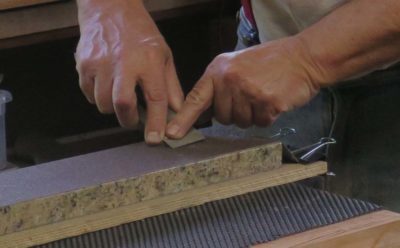
Then I start to introduce the curve on the bevel tip by rocking my body forward and backward, and swinging my arm in a pendulum fashion, moving the iron back and forth on the abrasive belt while maintaining the bevel angle. As I am doing this I rotate my hand to push down with my thumb and grind away the trailing corner on the push stroke and press down with my index finger on the opposite corner on the return trip. It really is almost effortless and idiot-proof. For this part of the process I usually wear cloth work gloves as the iron gets really hot, really fast.
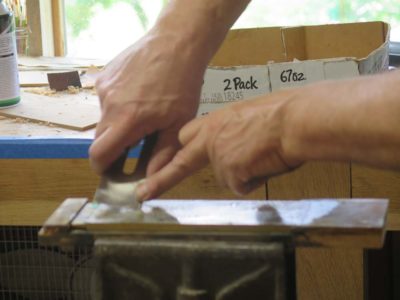
After I get the curved tip I want I move on to finish the iron on my 220 and 1200 diamond plates, then finish it off with the 8000 ceramic stone. Sorry for the fuzzy pic, it’s the curse of the “Automatic” setting on the camera. I use the exact same motion for the sharpening stones as I used for the rough shaping on the granite block.

Originally I titled this post “The 5-Minute Camber” but I timed myself as I created this one. I was off by 40%. It took me just over seven minutes to go from start to finish. Shoot, I took longer to do the photography. I’m trying to teach myself to make short “shop tip” videos, maybe this process would be a good candidate.


















Recent Comments